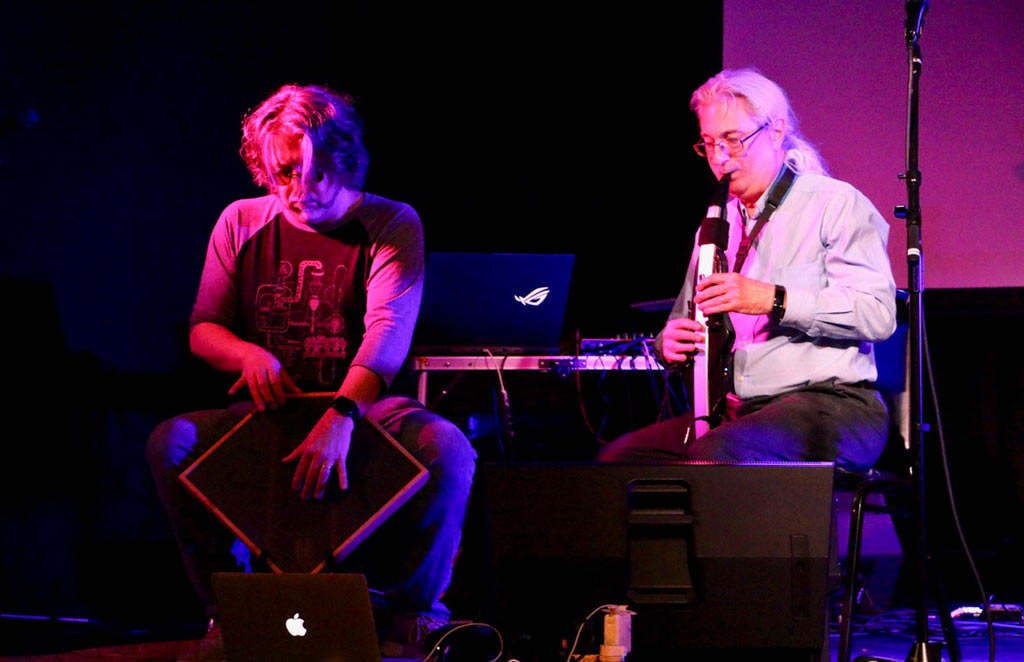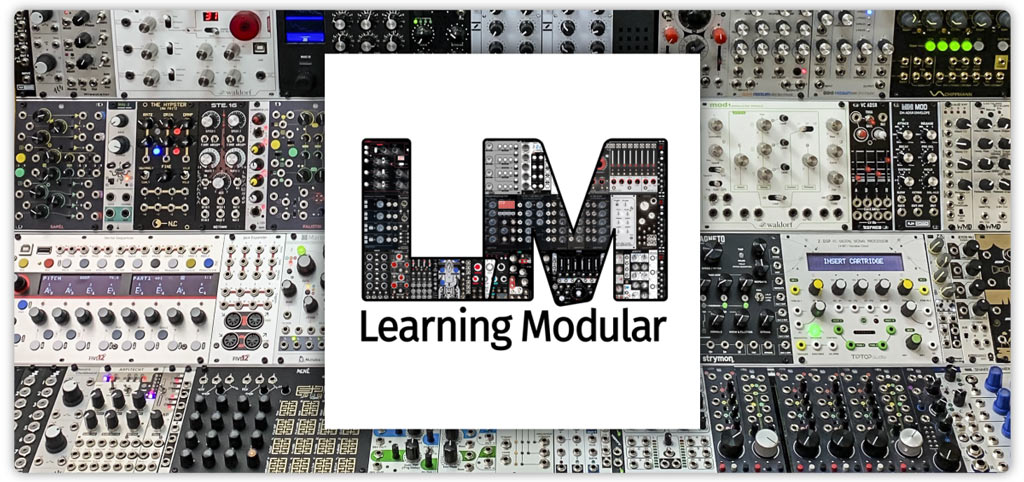Last month I played at the Mountain Skies 2022 Electronic Music Festival, where over 20 acts performed. Watching them got me thinking a lot more about how we can make our performances more accessible to our audiences; that’s the subject of the main article this month. I also share a video of my own performance.
In other news, all of my online modular synthesis courses are on sale this month! This is part of some re-arrangement I’m doing of my Learning Modular versus Alias Zone outlets, which will also be discussed below:
- featured article: When most musicians perform, it is possible to see exactly what they’re doing to create their music. This is rarely the case for electronic music performances. How can we improve that?
- Alias Zone updates: A video of my performance at Mountain Skies (The Barefoot Path), plus the upcoming release of my January performance (Compassion).
- Learning Modular updates: In response to inflation, I’ve decided to…not raise my prices, but instead put all of my courses on sale.
- Patreon updates: A detailed patch and performance breakdown of my Mountain Skies set, thoughts on how to prevent potential disasters while traveling and playing live, a peek into the past with Wavemakers synthesizers, and why I record 32-bit files.
- upcoming events: A live online interview with Shueh-li Ong of Oceanachine, as well as live performances in June at the Currents New Media Festival in Santa Fe, New Mexico and in July at SynthaCider in Lakewood (near Denver), Colorado.
- one more thing: It’s time I deal with my musical multiple personality disorder.
Can We Make Electronic Music Performances More Interesting to Watch?
As electronic musicians, what we actually do is largely a mystery to our audience – especially when compared to other common forms of music performance. I believe it is worth thinking about how we can change that, to both broaden and deepen our connection to our audience.
Speaking in broad terms, I suspect there are three main types of music concert attendees:
- Musicians who are curious to both see and hear other musicians (especially their peers and role models) play their instruments
- “Super fans” who are also curious to both see and hear their musical heroes create music
- Causal fans who want to hear the music with the benefit of also being able to watch the musicians create it
When a musician on stage is playing a stringed (guitar) or wind instrument, it’s easy to watch them create, including seeing their finger movements. The same is often true with percussionists.
With trap kit drummers, it’s harder to see what they are doing behind their instruments, but drum kits are often spread out enough with identifiable elements (that’s a cymbal, that’s a tom, etc.) that it’s not too hard to connect their arm movements to the resulting sounds.
It’s harder to see what keyboardists are doing, as they are often barricaded behind their equipment, but at least they often make eye contact with the audience. (The notable exception being singer/songwriters, who often turn their piano sideways so you can see them play in profile. The same has been true whenever I’ve seen a concert pianist play.)
Now compare that to most electronic music concerts: The musicians often set up in the traditional keyboard orientation of facing the audience, meaning their gear is between them and the audience – and facing toward them, not the audience. This is especially true for those who play modulars or laptops, but I’ve also seen it with electronic wind and string players who are also often seated behind keyboards or table-high sound modules and effects. In addition, electronic musicians are often so focused on what they’re doing that they rarely make eye contact with the audience.
As a result, at most electronic music concerts neither your fellow musicians nor your dedicated fans can see what you’re doing, leaving them frustrated. Causal fans also can’t make a connection between your gestures and the resulting music, meaning the live experience isn’t much better for them than a pre-recorded one. How is this helping you connect with your audience?
This is something I care deeply about. I don’t claim to have a perfect solution, but I have a few ideas – ones that I would like to see more electronic musicians at least try, and hopefully improve upon.
The simplest solution is that I turn my gear around, so that it is facing the audience instead of me. I firmly believe that most of the audience is far more interested in seeing my gear and how I am manipulating it, than seeing my face while performing – especially since I am usually focused on the gear and not making eye contact with them. I’ve tried turning around my system by 90°, 180°, and different angles in between, looking for what angle might be best for the largest number of those watching. The problem with a simple 180° rotation is that I am then standing in front of my gear, blocking those seated in the center from seeing it. My current live performance system is set up in a 60° to 90° arc around me, meaning about a 135° rotation from the normal performance setup seems to expose it to more people (see the image above).

A notable exception to the “I can’t see what you’re doing!” staging of most electronic music was this set by Paul Vnuk Jr. (on the left, playing an ATV aFrame) and Paul Harriman (on the right, playing a Roland Aerophone) at the Mountain Skies 2022 electronic music festival. Note that Paul Harriman even placed his laptop on the ground, where it was not obstructing the audience’s ability to see him play. (Photo by Geary Yelton.)
A second step is something that more venues – or people organizing concerts at temporary venues – should definitely install: a camera above the stage, looking down at the performers. When I am involved with staging a concert, I try to bring a camera and a ring light on a tall “boom” stand that I can place directly over performers.
Mountain Skies 2022, where I most recently performed, was held at White Horse Black Mountain, where RadHaus Studio had set up several cameras on and around the stage, plus had a roving cameraperson. This works great for most band situations, but there was no overhead view which would have been most beneficial for the electronic musicians they hosted that weekend. Still, I was told that my set – where I was rotated 135° from normal – made it one of the easiest to follow what I was doing on the resulting video stream. (That video is below, in the Alias Zone section of this newsletter; the still image at the top of this post is from that stream.)
An outside-the-box approach would be to look for venues with non-traditional viewing angles for the audience. At White Horse Black Mountain, we were on a stage raised above the audience, which did not help the viewing angles at all. Later in June, I’m playing in a small movie theater, set up on the ground level in front of the screen, while most of the audience will be seated in rows above ground level – that should work much better. A space designed to house plays where the audience is on raised seats or bleachers around the stage would also work. An extreme “solution” was the SoCal Synth Society NAMM Jam I attended just before Covid, held in the back room of a bar. People crowded all around, with the performer in the middle. This must have been uncomfortable for some performers, but it was certainly an intimate experience where you could really see what they were up to.
These are just suggestions for staging – they don’t require you to change how you’re actually playing. However, finding ways to make your gestures more obvious will also help your connection with the audience. For example, I have started placing items like a 1010music Blackbox or a Novation Launchpad on a boom that extends above or around the side of my modular, making it very obvious when I reach up and touch a pad to change the sound – this has gone over very well with the audience.
What are your suggestions? How do you think we can we make a better connection with our audience? Or do you think it is better if what we do remains at least slight mysterious?
Alias Zone Updates
Above is my most recent performance, at Mountain Skies 2022: The Barefoot Trail. It is based on the Zuni pilgrimage every four years on The Barefoot Trail to Zuni Heaven, starting with the story of how their ancestors emerged from The Underworld. It’s the most “acoustic” piece I’ve composed recently, integrating Native American chants and drums with my usual modular and virtual synthesizers and samples. After I got back from that trip, I recorded a version of it for a future album release; it is currently off to a couple of my old musician friends for potential overdubs.
In early June I’ll be releasing on Bandcamp my January performance at the SoCal Synth Society’s NAMMless Jamuary. It’s a piece called Compassion, which is a major update to a piece called Buddha of Compassion that I used to perform back around 2000 as well as more recently, pre-Covid. I will be performing a special quadraphonic version of this at the Currents New Media Festival later in June (see Upcoming Events below).
Learning Modular Updates
I know inflation has been putting pressure on a lot of people. So rather than raise my prices, I’ve decided to offer a sale on all of my online courses for the month of June, and made the lowest level of my Eurorack Expansion course free.
Remember: when you buy one of my courses, you get immediate access that does not expire until I decide to close down Learning Modular altogether (which I hope will be many years from now!).
I’ve also finished the closed captions for the core of my original Learning Modular Synthesis course, and will now turn my attention to adding them to the Mother-32 course.
Patreon Updates
During May, I wrote two long-form posts based around my new piece The Barefoot Trail: One that breaks down each of the sounds and performance decisions that went into an extended studio version of the piece, as well as a post on lessons learned from taking that piece on the road.
I also wrote a new Notes from the Studio, this one on why I record everything I do to 32-bit files. All three of those are available to +5v and above subscribers.
I also posted the video from the Mountain Skies live version of The Barefoot Trail, as well as a look back at a very rare make of semi-modular synthesizer: Wavemakers. Both of those posts are available free to everyone.
Finally, I tweaked the subscription levels for my Patreon channel, reflecting how it’s morphed over the past couple of years from primarily module videos to more information on composition, recording, and performance:
- The 1v/oct level is the “tip jar” for those who just want to support what I do (as well as get a post or two a month)
- The +5v level is for those who want access to all of my posts past, present, and future (including 3-5 new posts per month, on average)
- The +/-12v level is for those want access to all of my posts, as well as my Eurorack-centric online courses (Basic Concepts, the Comprehensive Starter Course, and the full Eurorack Expansion)
Previous subscribers keep the benefits they originally signed up for as long as they keep their subscription current.
Wondering if subscribing to my Patreon channel is right for you? Check out the index of articles I’ve already posted. Subscribe at the +5v or +/-12v levels, and you get access to all of those posts immediately!
Upcoming Events
June 4/5: Music & Chat live online interview on Oceanachine (Saturday 6:30 PM PDT / 9:30 PM EDT; Sunday 2:30 AM BST / 3:30 AM Sunday CEST / 11:30 AM Sunday ACT)
I’m being interviewed this coming Saturday evening US time (Sunday morning in Europe & Asia) by Shueh-li Ong on her Oceanachine program. We’ll be covering my career going all the way back to my days at Sequential (and maybe even before?), through my life in the “motion graphics” industry creating visuals for TV and film, to the present. It should be fun; I hope some of you can join us!
June 24: Performance at Currents New Media Festival (Center for Contemporary Arts, Santa Fe, New Mexico; 7:00 PM MDT)
I – as well as Sine Mountain (David Soto) and Jill Fraser – will be performing in quad during a special electronic music night during the festival. There will be no live stream of this event, and seating is limited, so plan on getting to the Center for Contemporary Arts earlier in the day to enjoy the Currents festival, and then get in line for admission to the concert afterwards. (There should also be the ability to purchase tickets ahead of time; keep an eye on the Sandbox Music web site.) Here is a link to all of the performances happening during the festival. Tickets are pay-what-you-can, with a recommended donation of $10; all proceeds go directly to the artists.
 July 2: Performance at SynthaCider (Locust Cider, Lakewood/Belmar Colorado, 6:30 PM MDT)
July 2: Performance at SynthaCider (Locust Cider, Lakewood/Belmar Colorado, 6:30 PM MDT)
I will also be playing a live set at Locust Cider in the Belmar section of Lakewood, Colorado (in the greater Denver area) the weekend after the Kraftwerk concert at nearby Red Rocks. Other artists that evening will include El Roachy, Moss Pig, and Modulus10. Admission is free (but do be sure to sample their ciders!).
Then I’ll be taking a little break before playing the Chill Out Room at Knobcon in September, and maybe at Synthplex in October as one half of Meridian Alpha. I’ll keep you posted.
One More Thing…
When it comes to my musical activities, I admit I’ve been suffering from a bit of a split-personality disorder … and I’m working to straighten that out.
I causally observe some Buddhist practices, and one of them is “follow the teachings; not the teacher.” The idea is to focus on the content of what is being shared, not just accept it because it came from a supposed master. That’s why I present my modular synthesis education as “by Learning Modular” rather than “by Chris Meyer”; I have a similar reason for continuing to use my old musical ensemble name “Alias Zone” for my newer solo work.
However, as I put more energy into my musical side compared to my educator side, I have to confront that Learning Modular has a very nice audience now (thank you), while Alias Zone currently has a relatively small audience. Which gets in the way of me wanting to share my music to a wider audience.
One of my musical mentors confronted me about this, and encouraged me to start using my own name more, rather than these “aliases” (no pun intended). At the very least, he suggested I rebrand “Alias Zone” to be “Chris Meyer’s Alias Zone” – which is a title I’ve now adopted for the “AZ” Bandcamp and Instagram pages.
In general, I am also trying to blur the lines between mastering the tech behind modular synths (and how to integrate them with others items in your studio), and creating music with them. This means you’re going to see me morph the names of more of my Learning Modular outlets – such as my “LM” Patreon channel, YouTube page, and more – to say “Chris Meyer: Learning Modular + Alias Zone”.
I hope you will continue to join me on this journey as I grow and evolve – and try to merge my split personalities back into one.
Thank you again for your support. All of my musical activities are funded by my musical income – which includes album sales, courses, Patreon, and Patch & Tweak royalties. The more I do, the more I learn, which means more information I can turn around and share with you in hopes it helps your own musical endeavors.
having the time of my life –
Chris






 July 2: Performance at SynthaCider (Locust Cider, Lakewood/Belmar Colorado, 6:30 PM MDT)
July 2: Performance at SynthaCider (Locust Cider, Lakewood/Belmar Colorado, 6:30 PM MDT)
Really enjoyed the June newsletter, read it top to bottom. Thinking strongly about building audience accessibility and benefit of realtime feedback. Sharing limited to enhance enthusiasm AND education. Strongly agree it demands readdressing. Simultaneous webcast but just visual… I’ll get back to you. Good stuff. Thanks for sharing
In the article on performance, I meant to add (only half tongue-in-cheek) that maybe this is a case to go 5U. Tangerine Dream, Node, Red Shift, Steve Roach, Klaus Schulze, etc. all had their modulars either facing the audience, or maybe in profile, so you could see them manipulating the equipment while they performed.